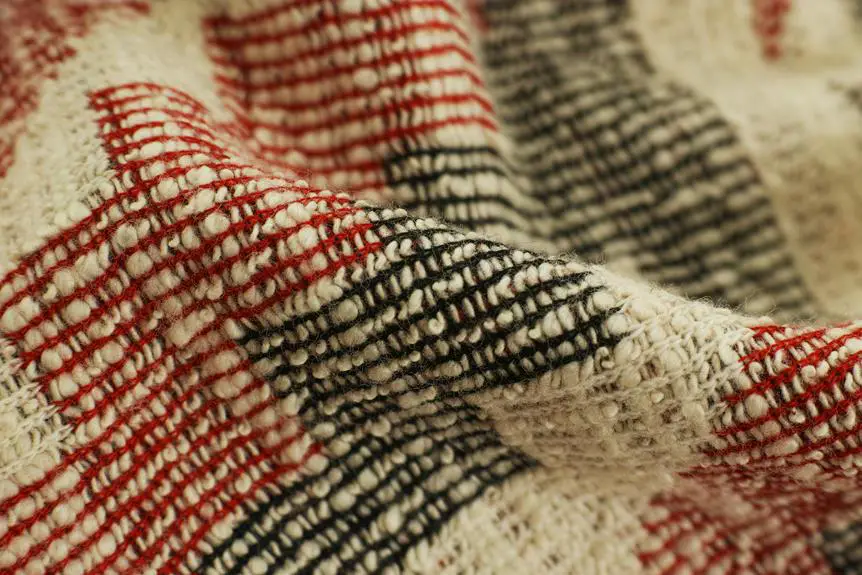When it comes to comfort, you've likely found yourself torn between poly tricot and cotton. Both fabrics have their strengths, but poly tricot's unique properties make it a strong contender for next-to-skin wear. You might be surprised to learn that poly tricot's moisture-wicking abilities far surpass those of cotton, leaving you feeling dry and comfortable even during intense activities. But how does this translate to everyday wear? Does poly tricot's softness and breathability make it a better choice for your wardrobe staples? Let's take a closer look at the key differences between these two fabrics to find out.
Table of Contents
Breathability and Airflow Comparison
When you compare poly tricot and cotton fabrics, you'll notice a significant difference in how they handle airflow and moisture transfer, with poly tricot often trapping heat and sweat, while cotton allows for better breathability and airflow.
This is because cotton is a natural fiber that allows air to pass through its weave, making it an excellent choice for warm-weather clothing or activewear.
On the other hand, poly tricot is a synthetic fabric that can be dense and tightly woven, restricting airflow and making you feel hotter and more uncomfortable.
As you wear poly tricot clothing, you may notice that it clings to your skin, especially when you sweat.
This is because the fabric doesn't allow for good airflow, causing the sweat to become trapped between your skin and the fabric.
In contrast, cotton fabrics tend to dry quickly and allow for better airflow, making them a more comfortable choice for everyday wear.
If you prioritize breathability and airflow in your clothing, cotton is likely the better choice for you.
Moisture-Wicking Properties Face-Off
Considering the breathability differences between poly tricot and cotton, it's also important to examine how these fabrics handle moisture-wicking properties, as this can greatly impact your comfort level during physical activity or in humid environments.
You'll want to know how well each fabric can draw sweat away from your skin and dry quickly. Poly tricot is generally a winner in this category, thanks to its synthetic fibers that allow for efficient moisture transfer. This means you'll stay drier and cooler for longer, reducing the risk of chafing and discomfort.
Cotton, on the other hand, absorbs moisture rather than wicking it away, which can lead to a clammy feeling and slower drying times.
In a face-off between the two, poly tricot's moisture-wicking properties give it a distinct advantage. You'll appreciate this during intense workouts or outdoor activities, where staying dry is crucial for performance and comfort.
While cotton has its strengths, poly tricot's ability to manage moisture makes it a better choice for high-intensity activities or humid climates. By understanding the moisture-wicking properties of each fabric, you can make informed decisions about what to wear for optimal comfort.
Softness and Texture Analysis
When you compare poly tricot and cotton fabrics, you'll notice distinct differences in their softness and texture.
To analyze these differences, you'll want to examine the fabric density of each material, assess their smoothness levels, and conduct a gentle touch test to see how they feel against your skin.
Fabric Density Comparison
You'll notice a significant difference in fabric density between poly tricot and cotton, with poly tricot generally having a softer and more pliable texture due to its unique weave and synthetic fibers.
When you hold both fabrics in your hands, you'll feel that poly tricot is lighter and more airy, while cotton is denser and heavier.
This difference in density affects how the fabrics drape on your body and how they breathe.
Poly tricot's lower density allows for better airflow and moisture wicking, making it a great choice for activewear and warm-weather clothing.
On the other hand, cotton's higher density provides more insulation and structure, making it suitable for colder climates and more formal wear.
When it comes to comfort, poly tricot's softness and pliability make it a winner for next-to-skin wear, while cotton's breathability and absorbency make it a great choice for casual, everyday wear.
Ultimately, the choice between poly tricot and cotton comes down to your personal preferences and needs. By considering the fabric density of each, you can make an informed decision about which fabric is best for your comfort and lifestyle.
Smoothness Level Analysis
The smoothness level of poly tricot and cotton fabrics is a key factor in determining their overall comfort and wearability, with poly tricot generally exhibiting a softer and more even texture than cotton. When you run your hands over poly tricot, you'll notice a consistent smoothness that's often lacking in cotton fabrics.
This is due to the unique weaving process used to create poly tricot, which produces a more uniform texture.
In contrast, cotton fabrics can sometimes feel slightly rough or uneven, particularly if they're made from lower-quality cotton or haven't been treated with a softening process.
This can be especially noticeable in clothing that's designed to be worn next to the skin, such as underwear or t-shirts.
Poly tricot's smoothness level also makes it less likely to irritate your skin or cause discomfort, making it a great choice for people with sensitive skin.
Gentle Touch Test
Run your fingers gently over poly tricot and cotton fabrics to experience the difference in softness and texture firsthand. You'll notice that poly tricot has a smooth, slippery feel, while cotton is generally softer and more breathable.
As you touch the fabrics, pay attention to how they interact with your skin. Poly tricot can sometimes feel slightly clammy or cool to the touch, whereas cotton tends to absorb moisture and regulate body temperature more effectively.
When you apply gentle pressure, you might find that poly tricot resists wrinkling and holds its shape well, while cotton is more prone to wrinkling and creasing.
However, cotton's natural fibers often provide a more comfortable, gentle caress against your skin. Poly tricot, on the other hand, can feel slightly more rigid or stiff, especially if it's a lower-quality fabric.
As you continue to explore the textures, consider how each fabric would feel against your skin for extended periods. Would you prefer the smooth, easy-care poly tricot or the soft, breathable cotton?
Wrinkle-Resistance and Durability
When it comes to withstanding wrinkles and wear, poly tricot generally outperforms cotton due to its synthetic fibers' inherent ability to spring back into shape and resist creasing. You'll notice that poly tricot fabrics tend to look newer for longer, even after repeated washing and wear. This is because the synthetic fibers are less prone to pilling and fraying, which can give cotton fabrics a worn and tired appearance.
Here's a comparison of poly tricot and cotton fabrics in terms of wrinkle-resistance and durability:
| Fabric Type | Wrinkle-Resistance | Durability |
|---|---|---|
| Poly Tricot | High | High |
| Cotton | Medium | Medium |
| Poly Tricot Blend | Medium-High | Medium-High |
| 100% Cotton | Low-Medium | Low-Medium |
As you can see, poly tricot fabrics tend to outperform cotton fabrics in terms of wrinkle-resistance and durability. This makes them a great choice for clothing and textiles that need to withstand heavy use and repeated washing. Whether you're looking for a low-maintenance wardrobe staple or a durable textile for your next project, poly tricot is definitely worth considering.
Thermal Regulation and Insulation
As you consider your fabric options, you'll want to think about how they'll help regulate your body temperature in different conditions.
Both poly tricot and cotton have unique properties that affect their ability to keep you warm or cool, depending on the situation.
Let's break down the key differences in body temperature control, moisture wicking ability, and cold weather insulation between these two fabrics.
Body Temperature Control
One of the most significant advantages of Poly Tricot over cotton lies in its superior thermal regulation, which helps you maintain a stable body temperature, whether you're lounging in warm weather or engaging in high-intensity activities.
This means you'll stay cooler in the summer and warmer in the winter, making it an ideal choice for clothing that needs to perform in various conditions.
When you wear Poly Tricot, you'll notice that it provides excellent insulation, trapping warm air close to your skin to keep you cozy in cold temperatures.
Conversely, its breathability allows heat to escape when you're warm, preventing overheating.
This balance of insulation and breathability makes it perfect for outdoor activities, such as hiking or skiing, where you need to regulate your body temperature effectively.
In contrast to cotton, Poly Tricot's thermal regulation is more consistent and reliable.
Cotton can become heavy and cold when wet, making it less effective at regulating body temperature.
With Poly Tricot, you can enjoy consistent comfort and temperature control, no matter the conditions.
This makes it an excellent choice for anyone seeking a comfortable and reliable fabric for their clothing.
Moisture Wicking Ability
Poly Tricot's ability to regulate body temperature is closely tied to its moisture-wicking properties, which enable it to draw sweat away from your skin and evaporate it quickly, keeping you dry and comfortable in a wide range of conditions. This is especially important during physical activity or in hot weather, where cotton fabrics can become heavy and clammy.
In contrast to cotton, Poly Tricot is designed to keep you cool and dry. Here's a comparison of the two fabrics in terms of moisture-wicking ability:
| Fabric | Moisture-Wicking Ability |
|---|---|
| Poly Tricot | Excellent moisture-wicking properties, drawing sweat away from skin quickly |
| Cotton | Poor moisture-wicking properties, retaining sweat and becoming heavy |
| Blend (Poly Tricot/Cotton) | Good moisture-wicking properties, but not as effective as pure Poly Tricot |
As you can see, Poly Tricot outperforms cotton in terms of moisture-wicking ability. This makes it an excellent choice for activewear, sportswear, and any clothing where you'll be sweating. By keeping you dry and comfortable, Poly Tricot helps you perform at your best and enjoy your activities without distraction.
Cold Weather Insulation
In cold weather, your clothing's ability to retain warmth and regulate your body temperature is crucial, and that's where Poly Tricot's thermal insulation properties come into play. You'll appreciate the warmth and coziness it provides when the temperature drops. But how does it compare to cotton in terms of cold weather insulation?
- Thermal retention: Poly Tricot is a better thermal insulator than cotton, meaning it retains warmth more effectively.
- Moisture evaporation: Poly Tricot allows moisture to evaporate quickly, reducing the risk of heat loss due to wet clothing.
- Wind resistance: Poly Tricot's dense weave provides better wind resistance, keeping cold air from penetrating the fabric.
- Layering versatility: Poly Tricot's thermal insulation properties make it an excellent choice for layering, allowing you to adjust your clothing to suit changing temperatures.
Skin Sensitivity and Allergy Concerns
When you have sensitive skin, it's essential to consider how fabrics like poly tricot and cotton will interact with your skin, as even mild reactions can cause discomfort and irritation.
You may be wondering how these two fabrics compare in terms of skin sensitivity and allergy concerns.
Cotton is generally considered a natural, breathable fabric that's gentle on skin. It's a popular choice for people with sensitive skin because it allows for airflow and moisture-wicking properties.
On the other hand, poly tricot is a synthetic fabric made from polyester. While it's often soft and smooth, some people may experience skin irritation or allergic reactions due to the fabric's synthetic materials.
If you have sensitive skin, you may want to opt for cotton over poly tricot. However, it's worth noting that some poly tricot fabrics are designed to be hypoallergenic and gentle on skin.
When shopping for clothing or fabrics, look for certifications like Oeko-Tex or skin-friendly labels. These can give you peace of mind and help you make an informed decision.
Frequently Asked Questions
Can Poly Tricot Be Used for Outdoor Gear?
You can definitely use poly tricot for outdoor gear, as it's durable, water-resistant, and quick-drying. It's a great choice for camping, hiking, or biking gear, and it's often used in jackets, pants, and backpacks.
Is Poly Tricot Suitable for Sensitive Skin Types?
You're probably wondering if poly tricot is gentle enough for sensitive skin types. Generally, poly tricot is considered hypoallergenic, but it's not as breathable as natural fibers. You may find it causes some irritation, especially in warm weather.
Does Poly Tricot Shrink in the Wash?
You might be wondering if poly tricot shrinks in the wash. Generally, poly tricot is a synthetic fabric that resists shrinkage, but it can still contract slightly if washed or dried at high temperatures, so be cautious.
Can Poly Tricot Be Ironed Like Cotton?
You'll find that poly tricot can be ironed, but it's essential to use a lower heat setting and a pressing cloth to prevent scorching or melting the fabric, unlike cotton which can handle higher heat.
Is Poly Tricot More Expensive Than Cotton?
You'll find that poly tricot's price varies depending on the quality and brand. Generally, it's cheaper than cotton, but high-end poly tricot fabrics can be pricier. You might pay more for specific blends or finishes.
- How Does Ring Spun Cotton Affect Garment Fit and Shape Retention? - August 13, 2024
- What Are the Challenges in Producing Ring Spun Cotton? - August 13, 2024
- Is Ring Spun Cotton Suitable for Plus-Size Clothing? - August 13, 2024







